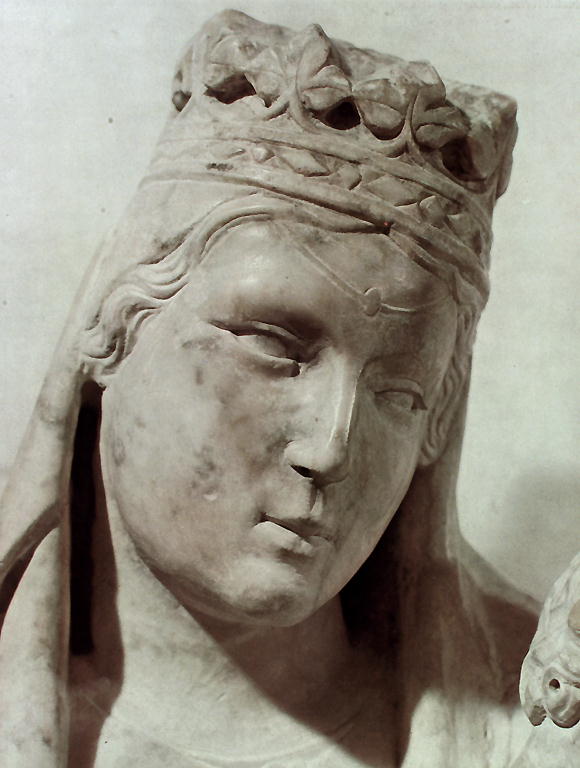We often say, in praising something from the past, that it is "recognizably modern." When we say that Emma Bovary or Clarissa Dalloway are modern, or that Michelangelo's David looks like a real teenager, or that Degas' paintings of the Place de la Concorde or the horse races are full of a modern life like our own, we take it for granted that these terms of praise are self-sufficient. Verrocchio's David, fine as it is, owes more to the Gothic than Michelangelo's does. It's not as recognizably modern and is therefore, somehow, not as good. (Our colloquial usage of "modern" is elastic, but we generally know what we mean by it, and one of its most vivid senses is "that which reminds us of ourselves").
Fictional characters that have an inconstant inner life are more like us and, therefore, better than those that don't. The Renaissance, it is universally acknowledged, was an improvement on what came before, whether we call that the Medieval Age, the Middle Ages, the Dark Ages, or the Gothic Period. And the instinct to think of it as better survives our brave efforts to disavow just that very instinct.
Why should it be so? Why should a certain increase in verisimilitude–for this seems to be what is at stake here, emotionally fleeting verisimilitude in particular–be taken for an improvement in quality?
After I came out of the Bargello yesterday, I was dazed by a contrary notion. In light of the sculptures by Ghiberti and Donatello, particularly those from the earlier parts of their careers and, going further back, in light of the sober 14th century stone and marble Madonnas, and the intricate 13th century ivory carvings from France and Italy, I felt a sudden call to the pre-secular. What drew me in was not simply the religious, which would imply creeds, but rather whatever that quality was in art that had not yet found its way to the permissiveness and sensual drama that began to predominate after 1420. Masaccio and Fra Angelico in painting and Brunelleschi and Donatello in sculpture mark the switch, though all four continued to retain traces of the international Gothic style. And the switch, of course, led to wonders.
Well. A strange thing happens: sometimes you see better the qualities of what's about to change. I love the International Gothic Style (to give the artistic tendency its official name), that isn't new, but seeing in one go so many works from a period when it was all beginning to change clarified for my eye not only what was being gained—the official story about the rebirth of art of course contains truths—but also what was being just as quickly lost.
There's a raw strength in an art that keeps its power hidden under the surface, an art with genuinely mystical referents. There's a seriousness that is the seriousness of early polyphony, of guilds, of anonymous carvers of genius (and many of indifferent ability), of tenebrous cathedrals in distant market towns, and the understanding that man is not, and ought not to be, the measure of all things. There's something in what historians of African Art used to call the "God-regarding" art.
These are images that are often not recognizably modern. They are depictions of people who do not share our passions, or at least not too many of them, people who do not meet us halfway, depictions that cannot be praised in the self-evident terms we put on Titian portraits or Hamlet; they lack the quicksilver dynamism of the Renaissance or of the modern in its various iterations; for teachers, they are not easy images to teach properly; and they nevertheless transcend their craftsmanship.
The subjects of these images, as well as the artists who made the images, are people who might find us—in our free state, with our improvised ways—unbuttressed, undefended, pitiful. The appeal of the pre-modern (this is what I’m thinking in the natural light of the old museum) is in its strangeness, its estrangement from us, its trust in a system we've since jettisoned.
I looked at those faces carved by a solidly godly people in the 1200s and 1300s, looked at the comfortingly unrecognizable expressions: the set of the jaw, the boneless faces, the blank eyes, the mystical smiles. It is a quiet intensity shared not with the classical or Hellenistic past (which in the boom-bust cycle of history had also fallen for a while into humanism and sensuality) but with the archaic practices of pre-classical Greece, the Etruscans, and the Near East.
It is an older language, a calmer, darker language; no less human, but other; a language possibly recognizable to us, after all, but only really to our God-regarding selves.
